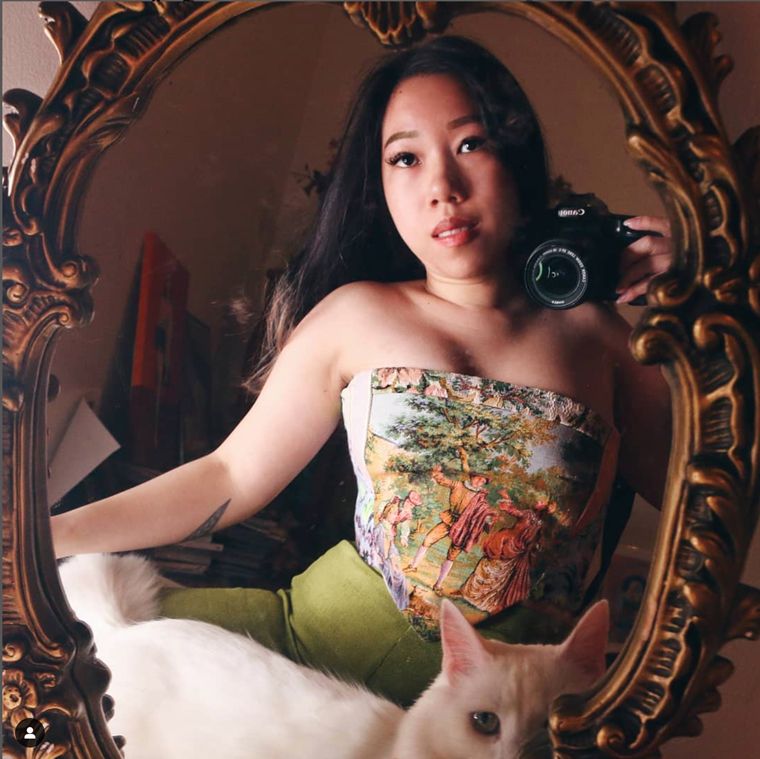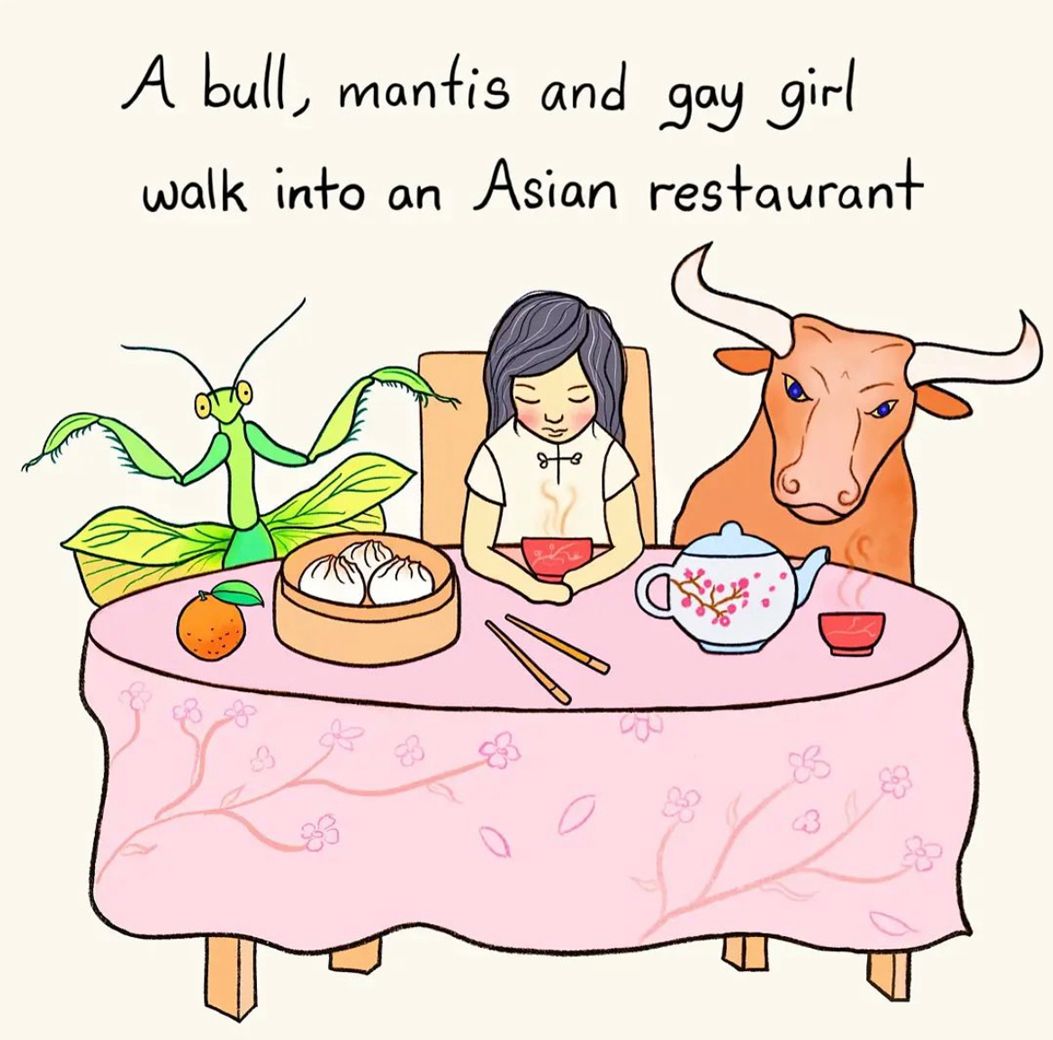Poems by Suri, aka Suri Chan, is a poet and artist who combines visual illustrations and free verse poetry. Her organic, unapologetic poetry is often deeply personal as she shares her experiences and struggles in the hopes of furthering Asian representation and visibility.
In an interview with Arts Help, Suri Chan shares her artistic journey, inspirations, and relationship with her social media platform.
Tell us a little about yourself!
I’m a queer Asian poet, artist and overthinker.
My work is inspired by the Chinese and Indian migrants I descended from — the ones who created recipes that tasted like home with the herbs of their new land. Their ingredients were generic: nuts, shredded veggies, sweet sauce. But they managed to create an earthy meal, grand enough to honour the New Year with. I like to think I do something similar by creating art from everyday words.
My poetry has appeared in Vocal Spotlight and Going Down Swinging. In 2021, I was chosen as a winner of the Moleskine “True Colors’’ Poetry Challenge.

What drew you to poetry and art? What kind of process did you go through to find your unique art style and artistic voice?
When I was a kid, people would tell my parents, “she’ll grow up to be an artist.’’ My dad would always say, “no, she’s going to be a lawyer — she’s very good at her studies, you know?’’ But I was always naturally creative. Growing up, I would spend ages drawing, crafting and making DIY Halloween costumes. I think I started writing because it’s one of the only art forms you can do alone in your room without any equipment or technical skills. Choosing to write because of “low barriers to entry’’ isn’t very romantic. But hey — it’s the truth.
As for my creative process — I don’t have anything specific, apart from keeping a soggy notebook in the bathroom (I get my best ideas in the shower)! All my ideas and imagery pop up at the most random moments. My main job is to quickly write them down before they’re lost forever!
Much of your work seems grounded in your personal experiences and the intersections in your identity, why do you think it is important to share and communicate these struggles and experiences?
Like most Asian kids, I was taught to sweep things under the rug to preserve the “family brand”. This approach erases our lived experiences — sometimes it erases actual people.
If you didn’t fit the “family brand” — for example, if you were gay, neurodivergent, or not “successful” in their eyes — you would be snipped out of conversations. To put it simply, it’s like you wouldn’t exist at all. My dad’s cousin comes to mind here. He has schizophrenia and paints brilliantly. For most of my life, I had no idea he existed because he never fit the “family brand”.
This is why it’s so important for me to be honest and open. I want to challenge the norms of my family because let’s face it — it’s gross to erase real people, and it’s dishonest to pretend we don’t have struggles or emotions. There’s so much value in holding your ugly parts to the light and allowing others to gather around to look at them. True connection comes when we see each other’s full selves, not when we’re preoccupied with making sure our baggage doesn’t leak from the corners of the carpet.
I share my struggles and experiences because they are collective struggles, shared by so many others in the queer and Asian communities. When we’re honest about our pain, we can all help each other carry it.
My mum’s first reaction to my Instagram was, “why are you sharing this? STOP before people see!” This is the same woman who hid her first marriage (and my half-siblings) from the world because a divorced woman is a shameful one. Her reaction proved to me how important it is, to be honest. It told me that I should keep going.

In your poem "Stale fruit & hand-me-down sexism" you talk about intergenerational sexism and how it is passed down through the women in the family through a visual analogy of cutting up fruit. How do you think combining visual language and text impacts how your poetry addresses these social issues?
A bowl of cut fruit is such a loaded symbol to Asian POC. Traditional Asian parents/grandparents aren’t very emotionally expressive — they don’t say “I love you’’ or show physical affection. Yet they always go out of their way to make sure you’ve had enough to eat.
Food is a vehicle for many Asian families to express love. A big home cooked meal or a bowl of cut fruit waiting for you on the table is a silent “I love you’’. Those images also symbolize the way values and biases are quietly passed down through the generations. I think visual poetry enters the “heart” before it reaches “the head”; certain pictures can instantly plunge us deep into our memories. There’s also something deeply primal about visual language because the human brain processes images 60,000 times faster than text. So, language that conjures up strong visuals is likely to hit our emotional core.
But honestly, I don’t intentionally write visual poetry because of this. I just happen to consistently get smacked in the head by images that want to become poems.
Based on your experience and platform on Instagram, what are some of the positive or negative aspects of your relationship as an artist with social media platforms?
If you publish something in a magazine, people read it, then move on. That’s it — at least in my personal experiences. With social media, I can continue the conversation with my audience long after a poem has been read. I LOVE having the privilege to do that. The ability to reach thousands of people around the world is also a major plus.
Not too long ago, writers were (mostly) tied to their physical location and at the mercy of gatekeepers. If you go back far enough, you’d have to stand in the town square screaming your poems to people on the street.
As for the negatives? Definitely the trolls and haters. Some people misinterpret my poems, and in turn, misinterpret me. A poem where I describe anxiety as an unwelcome visitor comes to mind. I gave anxiety “she/her’’ pronouns, and some very confused, very angry people called me a “sexist” — even though the poem had NO gender stereotypes whatsoever. I was simply using “she/her” pronouns because that’s what I use for literally all my characters!
You have to have pretty thick skin to last on social media — some people will not hesitate to call your writing “half-assed”. Once, a complete stranger told me I’m “not queer’’ because they didn’t like an LGBT poem I wrote! When I asked for clarification, they said I should “turn into a red panda’’.
But even though the haters are annoying, they’re an inescapable part of this — when you crack your heart open in public, you’re bound to attract some fruit flies.
Art can be a vehicle of social change and a starter of important conversations. Is there a particular social cause or United Nations Sustainable Development Goal that particularly speaks to you right now?
Goal 4: Quality Education for all. Education — when done right, with minimal biases — is a kind of freedom. I recently asked my mum why she chose to have children. She said, “I never thought about it. It was just something you did.’’ I am so much freer than her, and many of the women in my family, because my education gave me access to different worldviews and encouraged critical thinking.
I wish all the women in my family were as lucky as me.
See more of Suri Chan’s work here.
